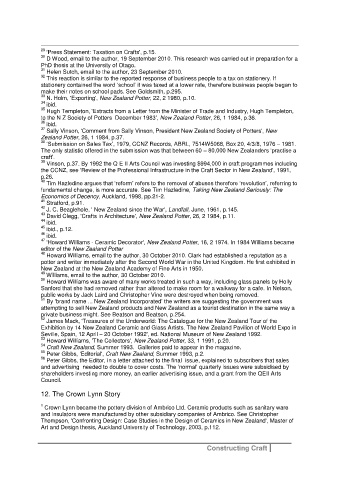Page 316 - Constructing Craft
P. 316
29 'Press Statement: Taxation on Crafts', p.15.
30
D Wood, email to the author, 19 September 2010. This research was carried out in preparation for a
PhD thesis at the University of Otago.
31
Helen Sutch, email to the author, 23 September 2010.
32
This reaction is similar to the reported response of business people to a tax on stationery. If
stationery contained the word ‘school’ it was taxed at a lower rate, therefore business people began to
make their notes on school pads. See Goldsmith, p.295.
33
N. Holm, 'Exporting', New Zealand Potter, 22, 2 1980, p.10.
34 ibid.
35
Hugh Templeton, 'Extracts from a Letter from the Minister of Trade and Industry, Hugh Templeton,
to the N Z Society of Potters December 1983', New Zealand Potter, 26, 1 1984, p.36.
36
ibid.
37
Sally Vinson, 'Comment from Sally Vinson, President New Zealand Society of Potters', New
Zealand Potter, 26, 1 1984, p.37.
38
‘Submission on Sales Tax’, 1979, CCNZ Records, ABRL, 7514W5068, Box 20, 4/3/8, 1976 – 1981.
The only statistic offered in the submission was that between 60 – 80,000 New Zealanders ‘practise a
craft’.
39
Vinson, p.37. By 1992 the Q E II Arts Council was investing $994,000 in craft programmes including
the CCNZ, see 'Review of the Professional Infrastructure in the Craft Sector in New Zealand', 1991,
p.26.
40
Tim Hazledine argues that ‘reform’ refers to the removal of abuses therefore ‘revolution’, referring to
fundamental change, is more accurate. See Tim Hazledine, Taking New Zealand Seriously: The
Economics of Decency, Auckland, 1998, pp.21-2.
41
Stratford, p.91.
42 J. C. Beaglehole, ' New Zealand since the War', Landfall, June, 1961, p.145.
43
David Clegg, 'Crafts in Architecture', New Zealand Potter, 26, 2 1984, p.11.
44 ibid.
45
ibid., p.12.
46 ibid.
47
'Howard Williams - Ceramic Decorator', New Zealand Potter, 16, 2 1974. In 1984 Williams became
editor of the New Zealand Potter
48
Howard Williams, email to the author, 30 October 2010. Clark had established a reputation as a
potter and writer immediately after the Second World War in the United Kingdom. He first exhibited in
New Zealand at the New Zealand Academy of Fine Arts in 1950.
49
Williams, email to the author, 30 October 2010.
50
Howard Williams was aware of many works treated in such a way, including glass panels by Holly
Sanford that she had removed rather than altered to make room for a walkway for a cafe. In Nelson,
public works by Jack Laird and Christopher Vine were destroyed when being removed.
51
By ‘brand name ... New Zealand Incorporated’ the writers are suggesting the government was
attempting to sell New Zealand products and New Zealand as a tourist destination in the same way a
private business might. See Beatson and Beatson, p.254.
52
James Mack, 'Treasures of the Underworld: The Catalogue for the New Zealand Tour of the
Exhibition by 14 New Zealand Ceramic and Glass Artists. The New Zealand Pavilion of World Expo in
Seville, Spain, 12 April ‒ 20 October 1992', ed. National Museum of New Zealand 1992.
53
Howard Williams, 'The Collectors', New Zealand Potter, 33, 1 1991, p.20.
54
Craft New Zealand, Summer 1993. Galleries paid to appear in the magazine.
55
Peter Gibbs, 'Editorial', Craft New Zealand, Summer 1993, p.2.
56
Peter Gibbs, the Editor, in a letter attached to the final issue, explained to subscribers that sales
and advertising needed to double to cover costs. The 'normal' quarterly issues were subsidised by
shareholders investing more money, an earlier advertising issue, and a grant from the QEII Arts
Council.
12. The Crown Lynn Story
1
Crown Lynn became the pottery division of Ambrico Ltd. Ceramic products such as sanitary ware
and insulators were manufactured by other subsidiary companies of Ambrico. See Christopher
Thompson, 'Confronting Design: Case Studies in the Design of Ceramics in New Zealand', Master of
Art and Design thesis, Auckland University of Technology, 2003, p.112.
Constructing Craft

